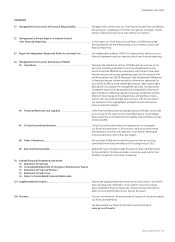GE 2011 Annual Report Download - page 43
Download and view the complete annual report
Please find page 43 of the 2011 GE annual report below. You can navigate through the pages in the report by either clicking on the pages listed below, or by using the keyword search tool below to find specific information within the annual report.’
GE 2011 ANNUAL REPORT 41
management, regulatory assessments, earnings, dividends and
compliance. GE Capital determines its risk appetite through
consideration of portfolio analytics, including stress testing and
economic capital measurement, experience and judgment of
senior risk offi cers, current portfolio levels, strategic planning,
and regulatory and rating agency expectations.
The Enterprise Risk Appetite is presented to the GECC Board
and the GE Risk Committee for review and approval at least annu-
ally. On a quarterly basis, the status of GE Capital’s performance
against these limits is reviewed by the GE Risk Committee.
GE Capital acknowledges risk-taking as a fundamental charac-
teristic of providing fi nancial services. It is inherent to its business
and arises in lending, leasing and investment transactions under-
taken by GE Capital. GE Capital utilizes its risk capacity judiciously
in pursuit of its strategic goals and risk objectives.
GE Capital uses stress testing for risk, liquidity and capital
adequacy assessment and management purposes, and as an
integral part of GE Capital’s overall planning processes. Stress
testing results inform key strategic portfolio decisions such
as capital allocation, assist in developing the risk appetite and
limits, and help in assessing product specifi c risk to guide the
development and modifi cation of product structures. The ERMC
approves the high-level scenarios for, and reviews the results of,
GE Capital-wide stress tests across key risk areas, such as credit
and investment, liquidity and market risk. Stress test results are
also expressed in terms of impact to capital levels and metrics,
and that information is reviewed with the GECC Board and the
GE Risk Committee at least twice a year. Stress testing require-
ments are set forth in GE Capital’s approved risk policies. Key
policies, such as the Enterprise Risk Management Policy, the
Enterprise Risk Appetite Statement and the Liquidity and Capital
Management policies are approved by the GECC Board and the
GE Risk Committee at least annually. GE Capital, in coordination
with and under the oversight of the GE CRO, provides risk reports
to the GE Risk Committee. At these meetings, which occur at least
four times a year, GE Capital senior management focuses on the
risk strategy and the risk oversight processes used to manage the
elements of risk managed by the ERMC.
Operational risks are inherent in GE Capital’s business
activities and are typical of any large enterprise. GE Capital’s
Operational Risk Management program seeks to effectively
manage operational risk to reduce the potential for signifi cant
unexpected losses, and to minimize the impact of losses experi-
enced in the normal course of business.
Additional information about our liquidity and how we man-
age this risk can be found in the Financial Resources and Liquidity
section. Additional information about our credit risk and GECS
portfolio can be found in the Financial Resources and Liquidity
and Critical Accounting Estimates sections. Additional informa-
tion about our market risk and how we manage this risk can be
found in the Financial Resources and Liquidity section.
Segment Operations
Effective January 1, 2011, we reorganized the former Technology
Infrastructure segment into three segments—Aviation,
Healthcare, and Transportation. The prior-period results of the
Aviation, Healthcare and Transportation businesses are unaf-
fected by this reorganization. Results of our formerly consolidated
subsidiary, NBCU, and our current equity method investment in
NBCU LLC are reported in the Corporate items and eliminations
line on the Summary of Operating Segments.
Our six segments are focused on the broad markets they
serve: Energy Infrastructure, Aviation, Healthcare, Transportation,
Home & Business Solutions and GE Capital. In addition to pro-
viding information on segments in their entirety, we have also
provided supplemental information for certain businesses within
the segments for greater clarity.
Segment profi t is determined based on internal performance
measures used by the Chief Executive Offi cer to assess the per-
formance of each business in a given period. In connection with
that assessment, the Chief Executive Offi cer may exclude matters
such as charges for restructuring; rationalization and other simi-
lar expenses; in-process research and development and certain
other acquisition-related charges and balances; technology and
product development costs; certain gains and losses from acqui-
sitions or dispositions; and litigation settlements or other charges,
responsibility for which preceded the current management team.
Segment profi t excludes results reported as discontinued
operations, earnings attributable to noncontrolling interests of
consolidated subsidiaries and accounting changes. Segment
profi t excludes or includes interest and other fi nancial charges
and income taxes according to how a particular segment’s man-
agement is measured—excluded in determining segment profi t,
which we sometimes refer to as “operating profi t,” for Energy
Infrastructure, Aviation, Healthcare, Transportation and Home &
Business Solutions; included in determining segment profi t, which
we sometimes refer to as “net earnings,” for GE Capital. Prior to
January 1, 2011, segment profi t excluded the effects of principal
pension plans. Beginning January 1, 2011, we began allocating
service costs related to our principal pension plans and no longer
allocate the retiree costs of our postretirement healthcare ben-
efi ts to our segments. This revised allocation methodology better
aligns segment operating costs to the active employee costs,
which are managed by the segments. This change does not sig-
nifi cantly affect reported segment results.
To better serve Oil & Gas customers, Energy’s Measurement
& Control business was moved to Oil & Gas in October 2011.
Measurement & Control addresses sensor-based measurement,
inspection, asset condition monitoring and controls needs. In
addition, three business units from Energy’s acquisition of Dresser
were also transferred to Oil & Gas in 2011. We have reclassifi ed
certain prior-period amounts to conform to the current-period
presentation. For additional information about our segments,
see Note 28.
























